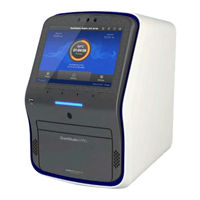ThermoFisher Scientific QuantStudio 7 Pro Manuals
Manuals and User Guides for ThermoFisher Scientific QuantStudio 7 Pro. We have 3 ThermoFisher Scientific QuantStudio 7 Pro manuals available for free PDF download: User Manual
ThermoFisher Scientific QuantStudio 7 Pro User Manual (269 pages)
Real-Time PCR System
Brand: ThermoFisher Scientific
|
Category: Laboratory Equipment
|
Size: 6.16 MB
Table of Contents
-
-
Workflow43
-
-
-
-
-
-
Array Card116
-
Require Sign-In131
-
-
Connect Platform133
-
-
-
-
PCR Instrument148
-
Software V2149
-
PCR Instrument151
-
Software V2151
-
-
-
-
PCR Instrument166
-
-
-
-
Install a Block178
-
Change the Block179
-
Remove the Block180
-
-
-
-
-
-
Connect Platform195
-
-
-
-
Networking227
-
-
Chemical Safety258
Advertisement
ThermoFisher Scientific QuantStudio 7 Pro User Manual (216 pages)
Real-Time PCR Systems
Brand: ThermoFisher Scientific
|
Category: Laboratory Equipment
|
Size: 4.74 MB
Table of Contents
-
-
Workflow38
-
-
-
-
-
-
Require Sign-In107
-
-
-
-
-
Install a Block143
-
Change the Block144
-
Remove the Block145
-
-
-
-
-
Networking180
-
-
Chemical Safety203
ThermoFisher Scientific QuantStudio 7 Pro User Manual (66 pages)
Real-Time PCR System
Brand: ThermoFisher Scientific
|
Category: Laboratory Equipment
|
Size: 0.72 MB
Table of Contents
Advertisement
Advertisement
Related Products
- ThermoFisher Scientific 75002421
- ThermoFisher Scientific 75002402
- ThermoFisher Scientific Thermo Scientific 7500 4532
- ThermoFisher Scientific Thermo Scientific 7500 4534
- ThermoFisher Scientific 75005703
- ThermoFisher Scientific 75005706
- ThermoFisher Scientific 75005723
- ThermoFisher Scientific 75005765
- ThermoFisher Scientific 75005720
- ThermoFisher Scientific 75003694


